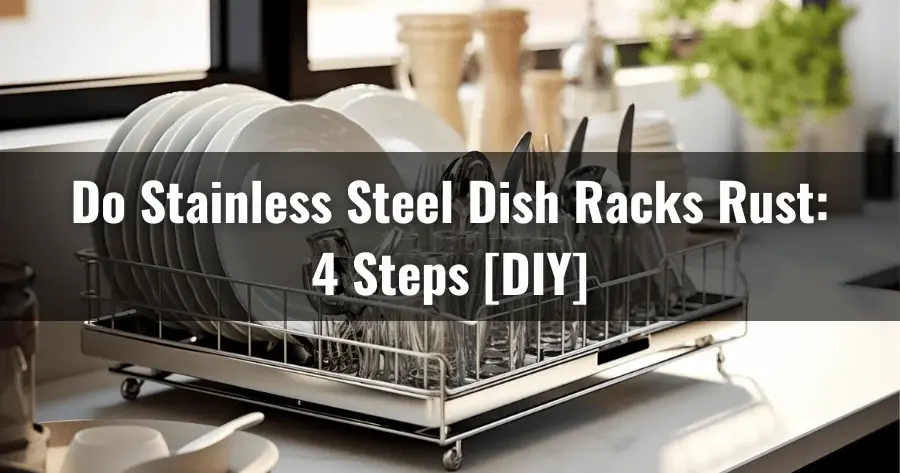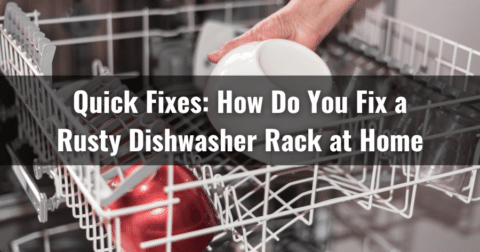Stainless steel utensil racks are a common kitchen accessory for many households, but have you ever noticed rust forming on your stainless steel dish rack? Generally, stainless steel racks don’t rust as much as others but can still develop rust if the thin chromium oxide coating is damaged.
This protective coating is responsible for preventing rust from forming on the surface of the rack. When this layer is compromised, moisture and oxygen can penetrate the steel, forming rust.
If you see brownish-yellow or reddish stains on a stainless steel dish rack wire, it indicates that rust has started to form.
Throughout this discussion article, we will discuss rust removal processes from stainless steel racks and how to prevent further corrosion. So keep reading for in-depth discussion.
Jump to Section
How to Clean Rust from Stainless Steel Dish Racks: DIY Steps to Follow
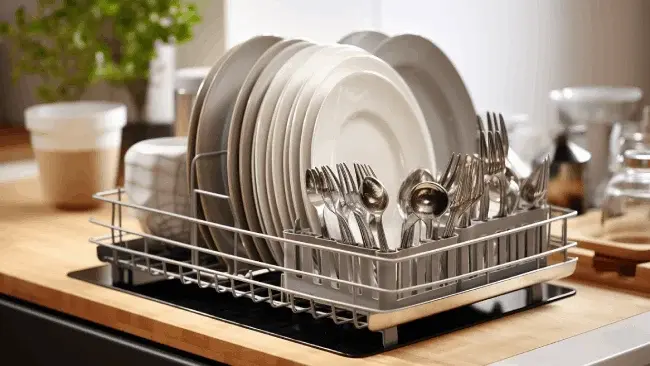
When cleaning rust from your stainless steel dish rack, you have a few DIY methods, such as:
- Baking soda method
- Vinegar method
- Lemon and baking soda method
- Commercial rust remover method
Let’s discuss these methods in detail:
1. Baking Soda Method
Mix 1 heaping tablespoon of baking soda with 2 cups of fresh, clean water to remove rust from your stainless steel dish rack. This mixture will create a paste that efficiently removes rust from the dish rack’s surface.
Take a clean cloth and apply the baking soda/water paste onto the rusted spots of the dish rack. Use moderate pressure and rub for a few minutes to break down and remove the rust flecks from the surface. Afterward, rinse the rack thoroughly with clean water to remove any remaining residue.
This method effectively removes rust and helps restore your stainless steel dish rack to its original condition.
2. Vinegar Method
If your dish rack is small enough, submerge it in white vinegar to remove rust. Pure white vinegar is a natural cleaning agent that can dissolve rust particles on stainless steel surfaces.
For too large a dish rack to be fully submerged, use a plastic spray bottle to apply vinegar directly onto the rusted sections. Allow the vinegar to sit on the rust for a few minutes or even several hours, depending on how severe the rust problem is.
Afterward, gently rub away the rusted areas with a regular kitchen sponge. Rinse the dish rack with fresh water and ensure it dries completely before using it again. The acidic nature of vinegar helps break down the rust while being gentle enough not to damage the stainless steel material.
3. Lemon and Baking Soda Method
Using equal parts fresh lemon juice and baking soda, you can create a paste that effectively removes rust from your dish rack. This method combines the acidity of lemon juice with the abrasive properties of baking soda to break down and dissolve rust.
The citric acid in the lemon juice acts as a natural cleaner. It helps to remove stubborn rust stains, and baking soda works as a gentle abrasive that helps to scrub away the rust without scratching or damaging the dish rack’s surface.
Applying this paste to all rusted areas and letting it sit for 30 minutes to an hour allows enough time for the mixture to penetrate and loosen the rust. Using a sponge or soft bristle brush, work the paste into the surface of your dish rack, covering all affected areas.
4. Commercial Rust Remover Method
Consider using a commercial rust remover (like CLR) if the lemon and baking soda method doesn’t work off your stainless steel dish rack effectively. Following the manufacturer’s instructions is crucial to ensure proper product usage.
Begin by applying the rust remover to the affected areas of the dish rack. Allow it to sit for the recommended time specified on the packaging. Using a scrub brush or sponge, vigorously scrub away any remaining rust stains.
Once thoroughly scrubbed, the dish rack rinses it with water to remove any residue from the rust remover solution. This is essential as leaving behind any solution traces may lead to further damage or discoloration of your stainless steel dish rack.
Future Rust Prevention on Stainless Steel Cookware Racks
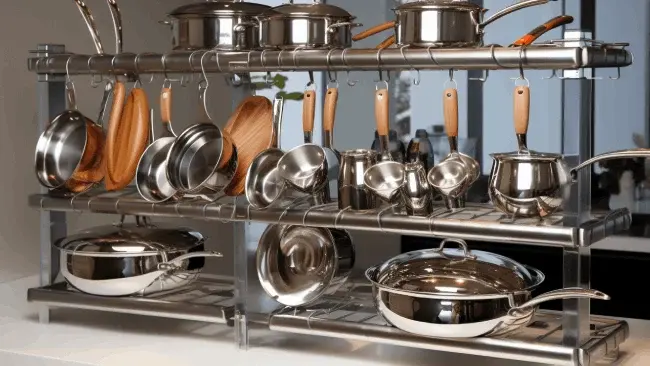
Keep these things in mind if you want your stainless steel dish rack to stay rust-free:
1. Avoid Prolonged Exposure to Water
Stainless steel racks are known for their durability and resistance to rust, but they are not completely immune. When water sits on the rack’s surface for an extended period, it creates a favorable environment for corrosion.
The moisture acts as an oxidation catalyst, speeding up the oxidation process and promoting the formation of rust. To prevent this, promptly dry your dishes after washing them and avoid leaving them on the rack for prolonged periods.
2. Thorough Drying
Ensure thorough drying after cleaning to prevent rust on your stainless steel dish rack. Water and moisture are major contributors to the formation of rust, so more than simply cleaning your dish rack is required.
You must also make sure it is completely dry before storing it. Pay special attention to the crevices and corners where water can easily accumulate. Use a clean cloth or allow the dish rack to air dry naturally to remove any remaining moisture.
3. Use Gentle Cleaning Tools
Scratches not only compromise the appearance of your dish rack but also create ideal conditions for rust to develop.
Soft-bristle brushes, microfiber cloths, or sponges can prevent scratches on your dish rack while cleaning them. These gentle cleaning tools are essential in maintaining the integrity of your stainless steel surface.
4. Avoid Salt Exposure
When living in a coastal area or dealing with salty water, it’s crucial to avoid salt exposure that can corrode stainless steel.
The high salinity levels in these environments can contribute to rust formation on stainless steel. Salt acts as a catalyst, accelerating the corrosion process and leading to the degradation of your dish rack.
To avoid this, it is recommended to rinse your stainless steel dish rack thoroughly after each use, particularly if you have used it near salt water sources.
5. Proper Utensil Placement
Ensure your utensils are dry and arranged properly on the dish rack to minimize scratches and prevent potential rust spots.
Consider their contact with the surface when placing stainless steel utensils on the rack. By arranging them to minimize contact, you can reduce the chances of scratches occurring.
Scratches not only affect the appearance of your utensils but also create opportunities for rust to develop. Rust spots can harm the longevity of stainless steel racks as they compromise their structural integrity.
FAQ’s: Do Stainless Steel Dish Racks Rust
1. Can I put wet dishes on a stainless steel dish rack?
Theoretically, you can place wet dishes on a stainless steel dish rack, but there are better practices than this. Stainless steel is highly resistant to rust, but that doesn’t mean it’s completely immune.
If you want to prevent rust spots from forming on your dish rack, it’s suggested that you gently wipe wet dishes before stacking them on the rack.
Stainless steel contains iron, chromium, and nickel, among other metals. While these metals are highly resistant to rust, they still contain small amounts of iron that can react to the air and moisture in the environment.
2. Is a coated dish rack better at preventing rust?
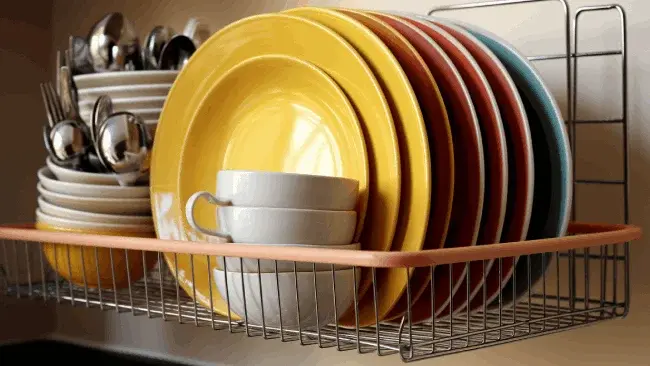
If you’re looking for extra protection against rust, a coated or finished stainless steel dish rack may be a good option. These racks are coated with a material layer that provides an extra barrier between the metal and the elements, helping prevent rust from forming.
However, these coatings can wear off over time. Even the most durable finish will eventually break down with regular use. This means proper care is still essential in keeping your dish rack rust-free, regardless of whether or not it has a coating.
3. How often should I clean my stainless steel dish rack?
Regular cleaning is key to preventing rust on your stainless steel dish rack. The frequency with which you should clean your rack will depend on a few factors, such as how often you use it and your environment.
As a general rule of thumb, it’s recommended that you wipe down your dish rack at least once a week. If you live in a humid or coastal area, clean your rack more frequently to keep moisture from building up.
Also, if you notice any food or hard water stains on your rack, it’s best to clean them immediately to prevent them from becoming permanent.
Conclusion
Stainless steel dish racks can indeed rust over time, but following the DIY steps outlined above, you can effectively clean and remove rust from your dish rack.
Also, taking preventive measures such as drying your dishes thoroughly before placing them on the rack and avoiding abrasive cleaning products can minimize the risk of future rusting.
We hope our article has been a good resource for understanding why rust forms on stainless steel dish racks and how to eliminate it. With proper care and maintenance routines, you can prevent future rust formation and keep your dish rack looking new and functioning correctly.


